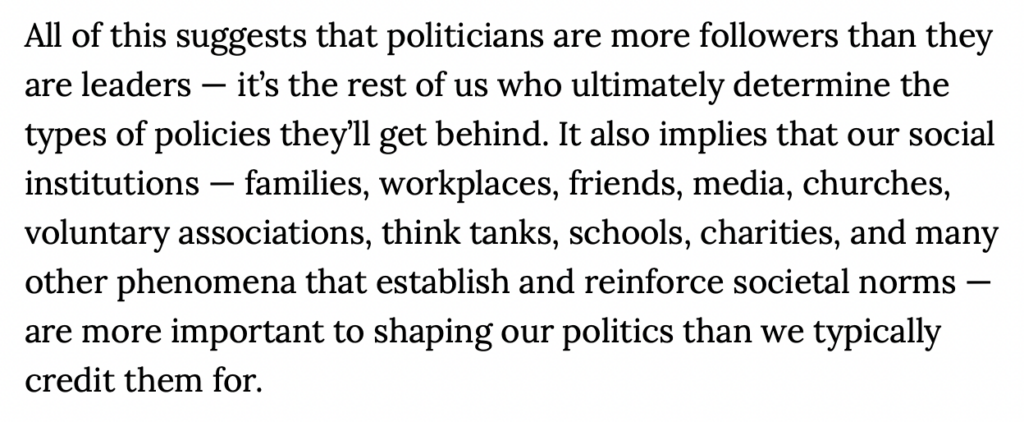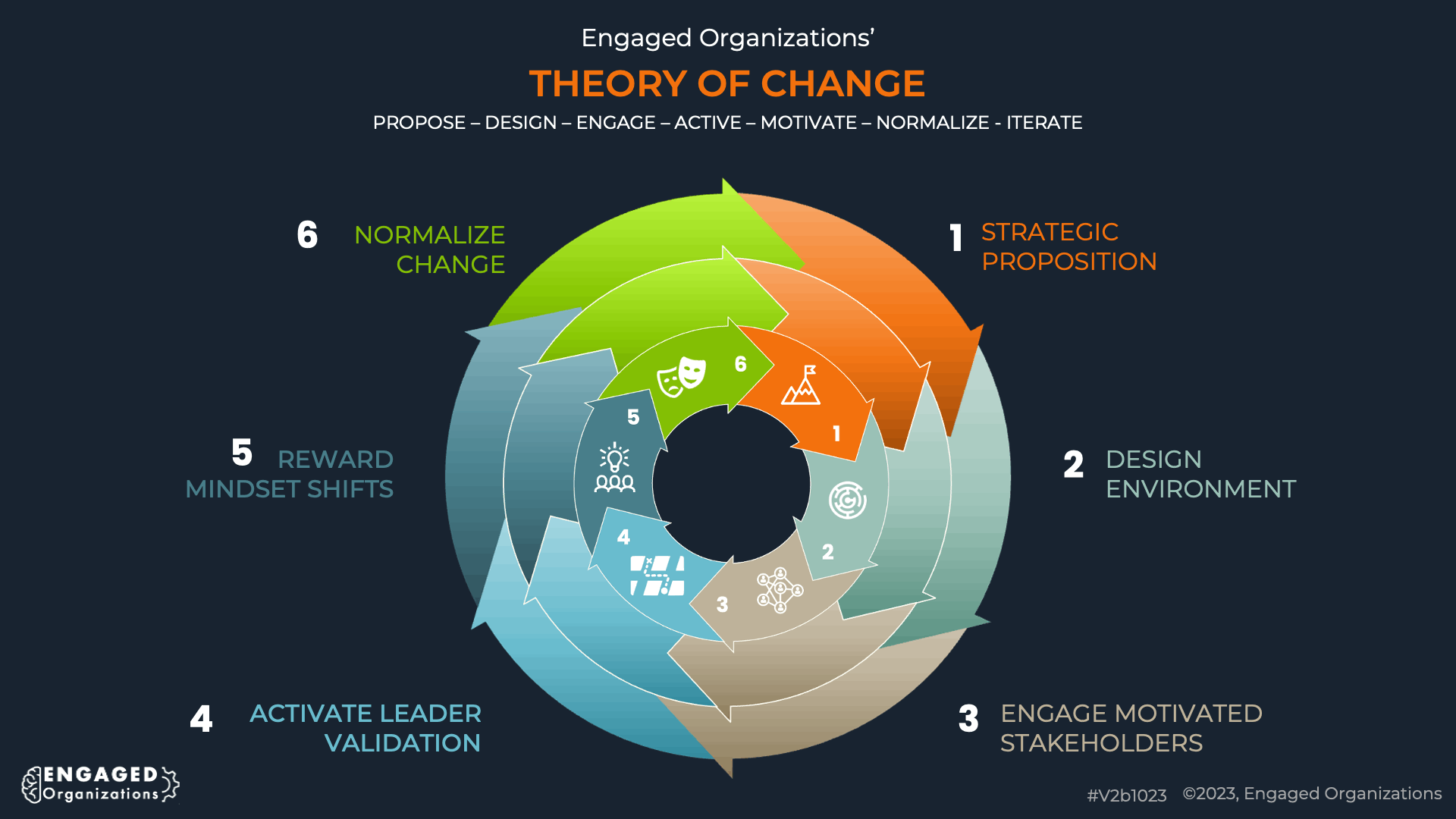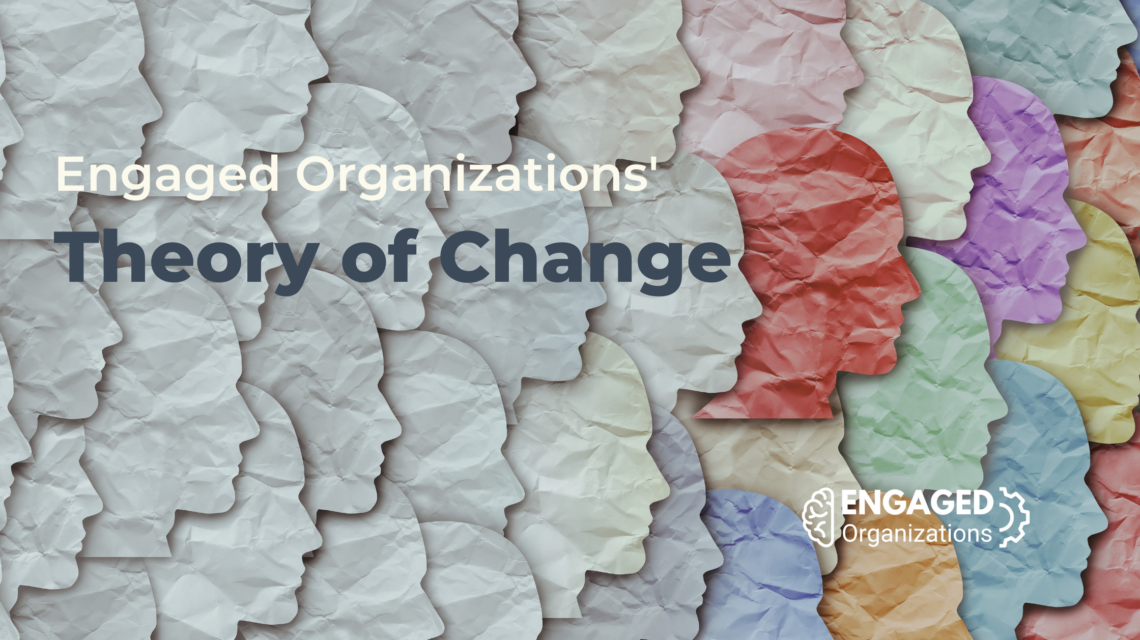A New Theory of Change for a New World of Work
My work with communities for the past decade was focused on how communities align ecosystems in a world of constant adaptation and that work is the foundation of Engaged Organizations’ Theory of Change. In a world of robots, automation, and AI work is changing at an accelerating pace and that means that organizations are changing – and change itself has to change.
Employees will transact less and discuss more; complete fewer tasks and spend more time reflecting; create less and design more.
The uniquely human value employees can offer in a world of automation is building trusting relationships, caring for others, facilitating alignment, recognizing opportunities, creating new solutions, and generating new ideas. It is work that is contextual, poorly measured, cannot be standardized, and requires emotional energy. If individuals feel controlled or coerced – even if that is subtle and implicit – this relational work cannot be done well.
Change Is Changing
Because work is changing, change is changing.
Many of the best-known change management frameworks make the implicit assumption that change is primarily a logical or design process, not a political or social one. This mechanistic view of change also implicitly assumes:
- A hierarchical, top-down approach to change is the most effective.
- Employees are standardized and interchangeable.
- Decisions about work do not need to include those doing the work.
These assumptions are rarely articulated but are revealed by using teams of consultants to document, assess, redesign, and implement work processes.
What these top-down approaches ignore is that:
- People do not like to be told what to do.
- The nervous system reacts to control like it does an attack that triggers a fight, flight or freeze response.
- The resistance triggered when change is foisted on people requires continued tacit coercion to sustain.
- Fight, flight, and freeze reactions result in the minimum effort required to comply with a demand.
- Anxiety throttles initiative, creativity, engagement, and additional discretionary effort.
- Mandated change requires high administrative costs to track and ensure compliance.
- The change management process itself is expensive because it requires a team to research, design, build, communicate, and train.
Ignoring the social and political aspects of change may make a change process easier to understand and more predictable, but it also dramatically increases the likelihood that it is unsuccessful. Control comes with significant risk.
Change is Constant; Resistance Is Optional
What if change could be navigated without triggering peoples’ fight, flight or freeze reaction?
What if changes were exciting and pursued instead of anxiety-provoking and resisted?
Individuals change all the time in imperceptible and incremental ways. Change happens when people read, learn, watch, interact, and experience new things. We change constantly, as do our communities.
This self-determined change is comfortable, desirable, and often energizing. It is also done in the context of our communities. The communities with which we identify influence our norms and beliefs and because we trust them, they are where we are most likely to discover new ideas and perspectives that influence us. Communities determine peoples’ expectations, influence behavior, and shape beliefs about what is possible. In politics, this is known as the Overton Window – and good politicians align with and work to shift that window over time.
 While leaders in organizations may not feel the need to consider the Overton Window of their employee community when they make decisions, when they do they can harness and extend existing norms to change culture without increasing friction. Removing friction enables an organization to move further faster.
While leaders in organizations may not feel the need to consider the Overton Window of their employee community when they make decisions, when they do they can harness and extend existing norms to change culture without increasing friction. Removing friction enables an organization to move further faster.
Strong Communities Invite Change
Strong communities are made up of strong relationships and individual agency; they enjoy high levels of trust, security, and diversity. Communities create belonging, which is defined by Brené Brown as the opposite of fitting in, the opposite of acclimating. It is feeling comfortable being unique. This comfort with diversity and authenticity also makes it comfortable to explore and change without risking relationships.
When leaders trust a community to contribute ideas and make decisions about a change, the dynamics shift significantly. Collaborating on change becomes a positive invitation to participate vs. a negative implied threat for not changing. It is an opportunity rather than an obligation. Joy instead of anxiety. Relational rather than transactional. Most valuable of all, it creates sustainable change.
Engaged Organization's Theory of Change
Strong communities are agile change agents by default. Using a community-centric approach to change in organizations requires a commitment to change how the organization thinks about and manages change – and a willingness for leaders to change. It requires that all stakeholder groups are considered, included and valued.
Community-centric change is not a discrete initiative but an ongoing conversation across groups. It is a fluid environment where some ideas are explored while other conversations are being refined and normed. It is agile by default.
There are six stages of agile, community-centric change:
- 1. Create Strategic Proposition
- 2. Design Environment
- 3. Engage Motivated Stakeholders
- 4. Collaborate to Create New Experiences
- 5. Reward Mindset Shifts
- 6. Normalize Change

I have experienced this approach to change in my personal life, I have facilitated this approach to change professionally, and I have advised clients on developing community-centric change programs. It is both successful and it creates an engaged, curious, supportive, and energized culture. In a world of overwhelm and anxiety, it is grounding and profoundly human and life-affirming.
Have you experienced this kind of community? Where? How did it feel?
Do you have questions, or would you like to discuss this? Please connect!



